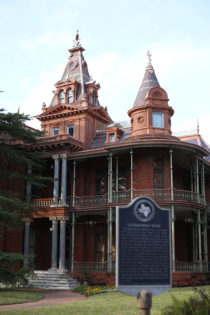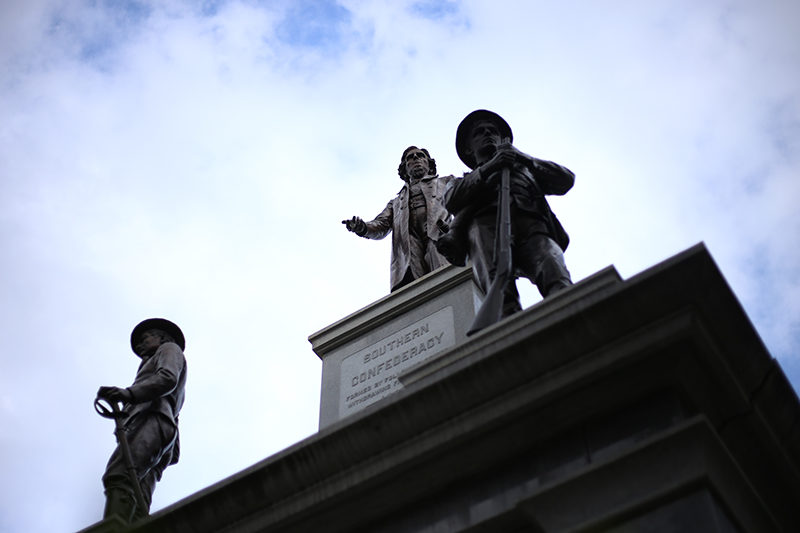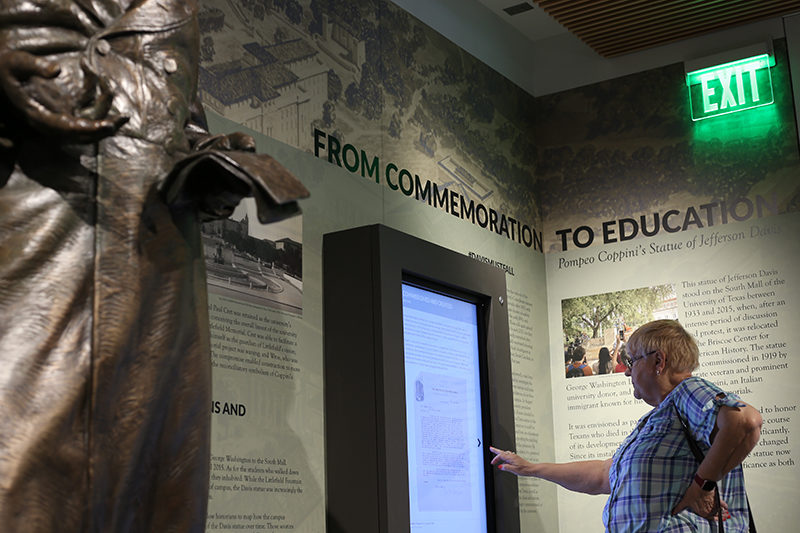Confederates Still Memorialized at UT; No Immediate Plans for Change
By Sunny Kim
Reporting Texas

A Confederate statue stands in front of the Capitol building in Austin, Texas. Brittany Mendez/Reporting Texas
Since a Confederate flag-waving white supremacist murdered nine black churchgoers in June 2015 in Charleston, S.C., Confederate symbols have come down around the nation. At the University of Texas at Austin, President Greg Fenves has ordered the removal of several such memorials from the university’s campus, including statues of Confederate President Jefferson Davis and Gen. Robert E. Lee.
Despite the relocation of some of UT-Austin’s prominent reminders of Confederate times, other nods to the Confederacy, hidden and not so hidden, continue to dot the campus and provide potential flashpoints for controversy. For the moment, administrators appear to have put the issue on the back burner. Whether the university will attempt to remove the symbols or rename buildings remains an open question, particularly given legislative efforts to stymie such efforts.
Ted Gordon, UT-Austin’s vice provost for diversity, has spent 20 years teaching students about Confederate artifacts on campus. It’s important “for people to … know what [the landmarks] mean,” Gordon said.

The Littlefield home on the campus of The University of Texas at Austin. Brittany Mendez/Reporting Texas
To educate students about how race is built into the physical environment, Gordon created an online “Racial Geography Tour” of campus. In a matter of clicks, visitors can view 360-degree videos of statues, buildings and other landmarks. Among them: Littlefield Mansion, named for former Confederate major and UT-Austin regent George Washington Littlefield; Clark Field, named for James Benjamin Clark, a former Confederate officer and subsequent university regent; and Roberts Hall Dormitory, named for Oran Milo Roberts, a Confederate officer and Texas secessionist leader who served as state governor from 1879 to 1883 before becoming a professor of law at UT-Austin.
In 2018, Fenves ordered the formation of a Campus Contextualization committee to advise his office on how to deal with UT’s nods to the Confederacy and other problematic memorials on campus. On May 16, the group had its first meeting since August.
Christina Baze, committee member and Graduate Student Assembly president, said the committee discussed revising “oversimplified” wording in a draft report to be more “historically accurate” in contextualizing memorials such as the Robert Lee Moore Hall, Painter Hall, Littlefield Fountain and remaining Confederate plinths around the South Mall. They are aiming to complete the four-page report by July 1.
“We talked about how the university has this responsibility to figure out what UT stands for, and the ethos that we want to perpetuate because it’s very relevant here,” Baze said.

Confederate statues stand in front of the Capitol building in Austin, Texas. Brittany Mendez/Reporting Texas
Meanwhile, the Texas Legislature is moving toward passing a law that would make it difficult, if not impossible, for state agencies, local governments and public universities, including UT-Austin, to remove or change historical monuments on state land. The House version of the bill would ban removal or alteration of statues and monuments more than 40 years old.
UT-Austin student government Vice President Mehraz Rahman, who sits on the Campus Contextualization committee, says because the university receives funding from the Texas Legislature, administrators have to be careful not to be too “vocal.”
“There [are] a lot of things that if they [university officials] were very vocal about, they might jeopardize for UT students, and that’s … not a risk that it seems like a lot of them are willing to take,” Rahman said.
When Fenves ordered the Jefferson Davis statue moved from the university’s Main Mall in 2015, he instructed that it be sent to the Dolph Briscoe Center for American History, where it is now displayed with historical context. In 2015, Fenves also ordered a statue of U.S. President Woodrow Wilson removed from its prominent campus location — to preserve what he called “the symmetry of the Main Mall.” Fenves said the Wilson statue would be relocated to an “appropriate exterior location on campus.”
After Fenves’ decision, students at Princeton University, where Wilson served as president before being elected president of the United States in 1912, protested Wilson’s views on race, unsuccessfully demanding his name be removed from campus buildings.

A statue of Jefferson Davis is seen in the Dolph Briscoe center at the University of Texas atAustin. Brittany Mendez/Reporting Texas
The Wilson statue is warehoused in the Briscoe Center’s offsite storage unit. Curators have restored the statue, but, unlike the Davis figure, it remains out of public view.
Meanwhile, UT-Austin’s plans for relocating the monument appear to have changed. “The president’s intention is that all of the statuary that was removed from the South Mall, including the Wilson statue, be in the collection of the Briscoe Center,” university spokesperson J.B. Bird said in an email.
In 2017, after a deadly white supremacist rally in Charlottesville, Va., intensified the criticism of Confederate symbols, Fenves ordered the removal of three more statues that honored Confederate leaders, including Robert E. Lee, Albert Sidney Johnston and John H. Reagan. They also reside in the Briscoe Center storage unit.
Don Carleton, Briscoe Center director, says he hopes to add an online contextualization for these statues to the Briscoe’s official website in the future. “I’m confident that we’ll get this done,” Carleton said. “We’ve had other projects in line ahead … of that, so it’s just a matter of getting to it.”
How to deal with Confederate symbols remains a hot-button issue in the community outside of UT-Austin’s Forty Acres. In January, complaints by state Rep. Eric Johnson, D-Dallas, led to the removal of a Confederate plaque from the Capitol. It inaccurately stated that the Civil War was “not rebellion, nor was its underlying cause to sustain slavery.”
On UT-Austin’s campus, perhaps one of the more overlooked artifacts is a Confederate seal located in the Life Science library in the university’s landmark central Tower. The seal is one of a series of emblems approved by the university regents in the 1930s to commemorate the six nations that have exercised sovereignty over Texas.
The seal quotes the preamble to the Confederate Constitution, which states, “We the people of the Confederate States … in order to form a permanent federal government, establish justice, insure domestic tranquility, and secure the blessings of liberty to ourselves and our posterity … do ordain and establish this Constitution for the Confederate States of America.”
UT-Austin senior Neanna Yi, who worked at the library in early 2019, was unaware of the seal’s presence until a visitor pointed it out, but she said “it’s very insensitive.” The university, she said, “should get rid of everything that’s Confederate-related, even if it’s historical, because if you display it on campus, it says you don’t really care about what happened to other people.”
History senior Andrew England disagrees. England is passionate about Confederate and Southern history, and said the removal of statues and artifacts is “disrespectful” and wants to see the statues back on campus “where they belong.”
“My goal is that we will see a movement going the other direction,” England said. “Instead of talking about sensitivity, we start honoring these people for their resumes and start showing a more mature understanding of history.”